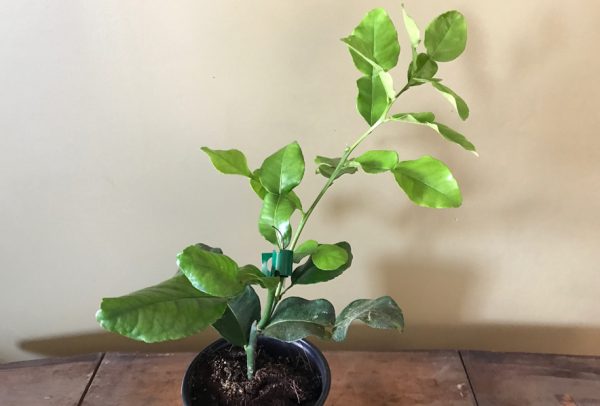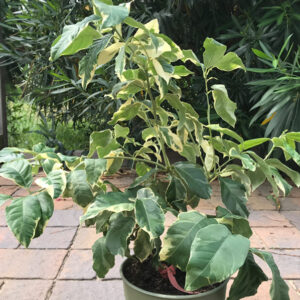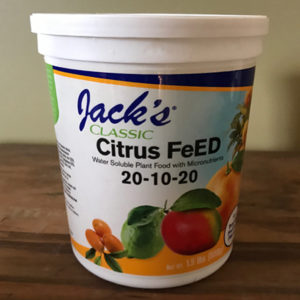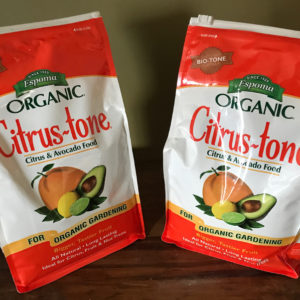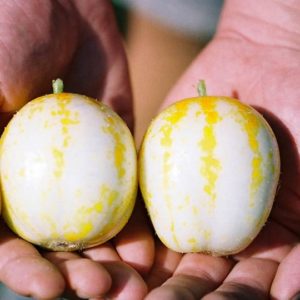Description
Citrus Tree, Kaffir Lime – Planting Instructions and History
Of the many plants that you can grow, that last for years and years, that produce delicious fruit and heavenly fragrances and are beautiful to look at, citrus trees top the list. YES, they can be grown inside for you city dwellers. YES, they do set fruit inside. YES, the fruit does mature and ripen inside. In Hardiness Zones 3-7, Citrus perform best when placed outside in full sun for the summer months, but they can be grown indoors all year round. If your citrus is not going to be outside, it needs to be in a south or west facing window. If your citrus spends the summer outside, it can be in any window when brought inside.
For those who love citrus, it might be time to grow your own. A family of four could survive with 4 orange trees, 2 lemon trees and 2 lime trees. From year 1 to year 3 the trees will produce 3-10 fruit per year, but starting in year 4, the lemons and limes could produce as many as 40 fruit per tree and the oranges could produce as many as 25 fruits per tree. Given what is happening in the American citrus industry, growing your own could be a viable alternative.
Citrus have been a part of human culture for thousands of years. The earliest written references regarding citrus discuss oranges and are dated at 2200 BC. There are ancient clues from wall paintings in the Egyptian temple at Karnak that citrus trees had been growing there. There were other suggestions that citrus trees may have been familiar to the Jews during their exile and slavery by the Babylonians in the 6th century BC.
Citrus in Europe and the Middle East were thought to have been naturally occurring native trees and shrubs, but historians today believe that the ancestor of the citrus trees, Citrus medica L., was introduced by Alexander the Great. The citrus he introduced was from India and he brought it to Greece, Turkey, and North Africa in the late 4th century BC. The first written discussion of citrus, Citrus medica L., in European history was done by Theophrastus, in 350 BC, following the introduction of the fruit by Alexander the Great. In early European history, writers wrote about Persian citrus, that it had a wonderful fragrance and was thought to be a remedy for poisoning, a breath sweetener, and a repellant to moths.
Throughout the ages, the fruit of citrus trees has been a symbol of eternal love, happiness, and even holiness. The Japanese believed citrus blossoms represented chastity, while the Saracens believed it was a symbol of fruitfulness. Kings and queens built entire indoor gardens around citrus; Arab women used its essence to color gray hair, and Nostradamus wrote about how to use its blossoms and fruit to make cosmetics. Hercules so valued it, he stole the golden fruit from Hesperides, who protected it as the primary food of the ancient Roman and Greek gods.
The citron was the first citrus fruit to attract the attention of Europeans, who were seeking trade routes to the Far East and its fabulous wealth. The citron, historically cedrate, is a large fragrant citrus fruit with a thick rind. It is said to resemble a ‘huge, rough lemon’. It is one of the original citrus fruits from which all other citrus types developed through natural hybrid speciation or artificial hybridization. The citron became established in Europe about 310 B.C., and was followed thereafter by the sour orange, the lemon, the sweet orange and, eventually, the pummelo, the earliest version of the grapefruit.
It is not known how, where, or when the exceptional present day varieties of citrus trees developed, such as the sweet orange, lemon, kumquat, lime, grapefruit, or pummelo, but there appears to be a general consensus of opinions that all these citrus developments and improvements were obtained by natural and artificial selection and natural evolution.
It is well known, that the Romans were familiar with the sour orange, Citrus aurantium L. and the lemon tree, Citrus limon. After the fall of Rome to the barbarian invasions and the Muslims, the Arab states rapidly spread the naturally improving cultivars of citrus fruits and trees throughout much of North Africa, Spain, and Syria.
The spread of sour orange, Citrus aurantium L., and the lemon, Citrus limon, extended the growing and planting of these trees on a worldwide scale by planting the seed, which produced citrus trees very similar to the parent trees. The Crusades conquest of the Arabs later spread citrus planting and growing throughout Europe.
The sweet orange, Citrus sinensis, appeared late in the 1400’s, near the time of Christopher Columbus. After trade routes were closed when the Turks defeated the Eastern Roman Empire in 1453, centered in Constantinople (Istanbul), many European kings began to seek alternate, trade, sea routes to open trade by ships with China and India. The sweet orange tree introduction into Europe changed the dynamics of citrus fruit importance in the world. The voyage of Portuguese explorer, Vasco de Gamma, recorded that in 1498, there were multitudes of orange trees in India, and all the fruits had a sweet taste. The new sweet orange variety, known as the “Portugal orange” caused a dramatic surge in citrus planting.
The lime, Citrus latifolia, was first mentioned in European history by Sir Thomas Herbert in his book, Travels, who recorded that he found growing “oranges, lemons, and limes” off the island of Mozambique in the mid 1600’s. Lime trees today are available in many cultivars.
The Mandarin orange, Citrus reticulata, was described in Chinese history in the late 1100’s, but was unknown in Europe, until it was brought from a Mandarin province in China to England in 1805, where it spread rapidly throughout Europe.
The pummelo, Citrus grandis, also called the shaddock and the ‘Adam’s Apple’ was growing in Palestine in the early 1200’s and was planted and grown by the Arabs. The pummelo is believed to have an Asian origin and was planted as seed in the New World.
The grapefruit, Citrus paradisi, is believed to have arisen as a mutation from the pummelo tree. Grapefruit were so named because they grew in clusters like grapes, but most gardeners considered them to be inedible until A.L. Duncan found an outstanding seedling grapefruit that was named Duncan grapefruit in 1892; the original tree is still alive and growing in Florida.
Christopher Columbus introduced citrus on the island of Haiti in 1493. It is believed that he brought citrus seed to be planted and grown of the sour orange, the sweet orange, citron, lemon, lime, and pummelo fruits. By 1565 records show that these citrus trees were well established in the coastal southeastern US at Saint Augustine, Florida, and in coastal South Carolina.
The early Spanish explorers, probably Ponce de Leon, planted the first orange trees around St. Augustine, Florida, sometime between 1513 and 1565. Grapefruit was a relative latecomer, arriving in Florida in 1806 courtesy of the French Count, Odet Philippe, who planted the first grove of grapefruit near Tampa, Florida, in 1823.
By the late 18th century, citrus trees could be found growing wild throughout many of Florida’s forests, and cultivated orange groves could be found along the St. John’s River and around Tampa. Florida’s unique sandy soil and subtropical climate were ideal for growing the seeds that early settlers planted.
Many of the wild orange groves were seen by the early American explorer, William Bartram, according to his book, Travels, in 1773, while traveling down the Saint John’s River in Florida. Bartram mistakenly thought these orange trees were native to Florida; however, they were established centuries earlier by the Spanish explorers. Bartram reported that Henry Laurens from Charleston, South Carolina, who served as a President of the Continental Congress, introduced “olives, limes, ginger, everbearing strawberry, red raspberry, and blue grapes” into the United States colonies after the year 1755. Bartram also reported that near Savannah, Georgia, “it is interesting to note that as late as 1790, oranges were cultivated in some quantity along the coast, and in that year some 3000 gallons of orange juice were exported.”
It took nearly 400 years from the time citrus was first introduced to Florida until enough was grown in the state to turn it into a profitable business venture. Soon after the Civil War, Florida’s annual commercial citrus production totaled one million boxes; it climbed to more than five million boxes by 1893. With the development of improved means of transportation, new markets were opened in the northeastern United States and demand for the refreshing, healthy benefits of Florida citrus started to expand slowly.
Today, citrus is marketed throughout the world as a beneficial health fruit that contains Vitamin C and numerous other vitamins and minerals.
Growing Citrus Trees in Containers
Citrus trees do require ongoing care, but with careful attention your citrus tree will be one of the most rewarding plants that you ever grow.
WARNING: Citrus trees need to be kept out of direct sunlight until planted. If their pot is left lying on its side in the sun, it will bake their roots and kill the plant immediately. As soon as you get your plant home, remove the plastic bag immediately.
- When you get your plant home, transplant it immediately into a 10-12 inch diameter pot that is 12-14 inches deep. In approximately 2 years, you will want to replant the tree into its final pot which should be 18-24 inches in diameter and 14-20 inches deep.
- We recommend a soil mix that consists of 60% topsoil and 40% peat moss. If you have clean sand available, you can use 20% clean sand, 40% topsoil and 40% peat moss. Do not use prepared soil mixes. They are too light and will not protect the tree and its roots if the plant is subjected to high winds. We recommend that you look at our YouTube video on soil at the following link:
The Best Soil Mix for Containers
Briefly, the soil mix we recommend is 60% topsoil, 20 % peat moss and 20% dehydrated manure.
- Place soil in the bottom of the pot. Remove the plant from its plastic pot and position it in the middle of the pot.
If the plant does not fit into the pot because its tap root is too long cut part of the tap root off. Never bend the tap root to make it fit into the pot. Fill the pot with soil around the plant until the new soil level is at the same level as the plant’s potted soil level. Pack the new soil around the existing soil well so all air is removed.
- Finish the transplanting process by watering thoroughly. You may need to water daily for the first week or two. NEVER let the tree stand in water. If the tree stands in water for even a short time 1-3 days, the tree will get root disease. After the first two weeks, you should allow the surface of the soil to dry before watering.
- Fertilize at least once a month with citrus fertilizer. Remember, citrus fertilizer contains micro-nutrients that are specific to this fertilizer which help prevent blossom drop and immature fruit drop. Two fertilizers that we recommend are Espoma CitrusTone and Jack’s Citrus Feed. We like CitrusTone when the plants are outside during the summer, but it stinks so during the winter when the plants are indoors we recommend watering with a half diluted solution of Jack’s Citrus Feed. Jack’s does not stink.
- Never let your plant be exposed to even a light frost. Most citrus can survive light frosts, but you usually will experience leaf drop. You should bring your tree indoors when the nighttime temperatures start routinely dipping into the 40s. We suggest that you should probably bring your plant inside several weeks before you turn the heat on. Citrus are very, very susceptible to changes in humidity and often lose all of their leaves when brought into a house where the heat is already on. Sometimes exposing your plant to several hours of humidifier misting helps.
- Citrus trees are frequently plagued with insects: spider mites, scale, mealy bug, etc. There are a number of sprays for these bugs, but you can also apply Bayer Fruit, Citrus and Vegetable. This product is a systemic and very easy to use. If you choose not to use insecticides try soapy water or Safer Soap. These are not quite as effective, but they do help.
CITRUS GREENING
Why Should You Be Interested in Growing Citrus? Because of this devastating disease:
Citrus Greening (Candidatus Liberibacter asiaticus) is one of the most serious citrus plant diseases in the world. It is also known as Huanglongbing (HLB) or yellow dragon disease. Once a tree is infected, there is no cure. While the disease poses no threat to humans or animals, it has devastated millions of acres of citrus crops throughout the United States and abroad. Citrus greening is spread by a disease-infected insect, the Asian citrus psyllid (Diaphorina citri Kuwayama or ACP), and has put the future of America’s citrus at risk. Infected trees produce fruits that are green, misshapen and bitter, unsuitable for sale as fresh fruit or for juice. Most infected trees die within a few years.
Huanglongbing (HLB) is thought to have originated in Asia and was first described in the early 1900s. The first detection of HLB in the United States occurred in Florida in 2005. Since 2005, HLB has spread through the citrus-producing areas in Florida, reducing citrus production by 75%, while more than doubling the cost of production. In 2008, HLB was detected in Louisiana, and in 2009, the disease was detected in Georgia and South Carolina. In 2012, HLB was detected in Texas and residential areas of California.
- The disease is currently found in California, Florida, Georgia, Louisiana, Puerto Rico, South Carolina, Texas and the U.S. Virgin Islands.
- The psyllids have been detected in Alabama, American Samoa, Arizona, California, Florida, Georgia, Guam, Hawaii, Louisiana, Mississippi, Northern Mariana Islands, Puerto Rico, South Carolina, Texas and the U.S. Virgin Islands.
The citrus greening bacterium and the Asian citrus psyllid spread on infected citrus plants and citrus plant material. Plants and material can spread the infection even if no psyllids are visible. Commercial citrus fruit, which is typically graded, washed, brushed and cleaned, is not known to spread the disease.
CITRUS TREES-THEIR HISTORY AND BACKGROUND
PLANTING CITRUS TREES IN CONTAINERS
HOW TO CARE FOR CITRUS TREES
THE KAFFIR LIME – AN ASIAN HEIRLOOM
THE LEGENDARY MEYER LEMON TREE
THE PINK VARIEGATED LEMON – A TRUE AMERICAN HEIRLOOM
THE PERSIAN LIME TREE

